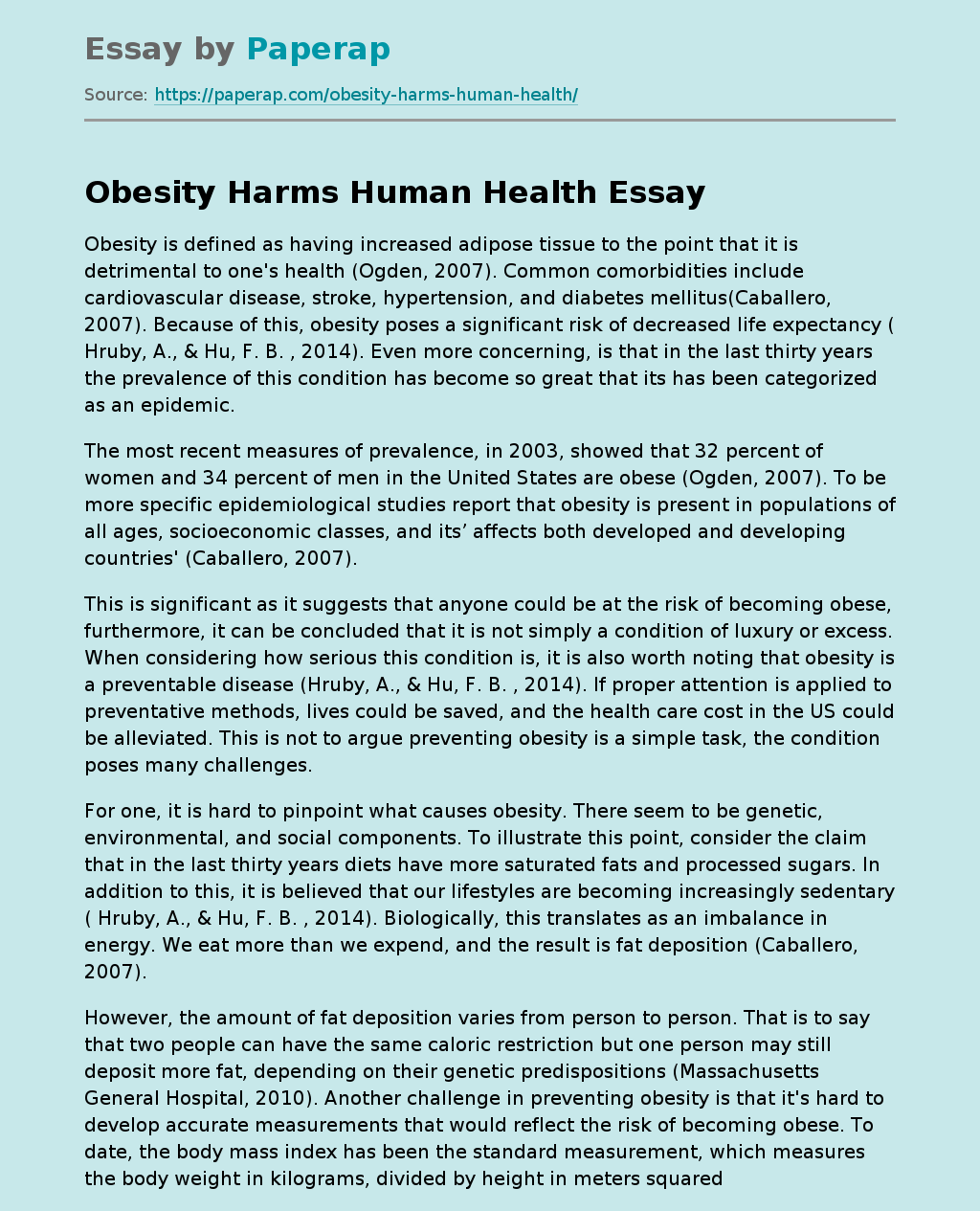Obesity Harms Human Health
Obesity is defined as having increased adipose tissue to the point that it is detrimental to one’s health (Ogden, 2007). Common comorbidities include cardiovascular disease, stroke, hypertension, and diabetes mellitus(Caballero, 2007). Because of this, obesity poses a significant risk of decreased life expectancy ( Hruby, A., & Hu, F. B. , 2014). Even more concerning, is that in the last thirty years the prevalence of this condition has become so great that its has been categorized as an epidemic.
The most recent measures of prevalence, in 2003, showed that 32 percent of women and 34 percent of men in the United States are obese (Ogden, 2007).
To be more specific epidemiological studies report that obesity is present in populations of all ages, socioeconomic classes, and its’ affects both developed and developing countries’ (Caballero, 2007).
This is significant as it suggests that anyone could be at the risk of becoming obese, furthermore, it can be concluded that it is not simply a condition of luxury or excess. When considering how serious this condition is, it is also worth noting that obesity is a preventable disease (Hruby, A.
, & Hu, F. B. , 2014). If proper attention is applied to preventative methods, lives could be saved, and the health care cost in the US could be alleviated. This is not to argue preventing obesity is a simple task, the condition poses many challenges.
For one, it is hard to pinpoint what causes obesity. There seem to be genetic, environmental, and social components. To illustrate this point, consider the claim that in the last thirty years diets have more saturated fats and processed sugars.
In addition to this, it is believed that our lifestyles are becoming increasingly sedentary ( Hruby, A., & Hu, F. B. , 2014). Biologically, this translates as an imbalance in energy. We eat more than we expend, and the result is fat deposition (Caballero, 2007).
However, the amount of fat deposition varies from person to person. That is to say that two people can have the same caloric restriction but one person may still deposit more fat, depending on their genetic predispositions (Massachusetts General Hospital, 2010). Another challenge in preventing obesity is that it’s hard to develop accurate measurements that would reflect the risk of becoming obese. To date, the body mass index has been the standard measurement, which measures the body weight in kilograms, divided by height in meters squared ( Ogden, 2007). However, BMI measurement is not a very accurate measure, as it is only correlational to fat deposition and doesn’t take into other variables that affect weight, such as bone density (Hu F,2008 ).
The most accurate way to measure fat deposition is to use MRI, however, this is impractical and costly. (Hu F, 2008) Finally, treating obesity poses a significant challenge. Strategies of combined caloric restriction and exercise are somewhat effective but are hard to maintain. (Thompson et al.,2007). Pharmacologically the use of appetite suppressants increases weight loss but has undesirable side effects (Thompson et al., 2007). The most effective treatment is a surgical gastric bypass, however even this has major side effects such as malabsorption of nutrients (Thompson et al., 2007). I chose Obesity for my social media project because I feel knowledgeable about the pathophysiology of the disease, but I would like to know more about what influences its current prevalence. I also recognize obesity as deserving a lot of attention as it is an epidemic and any efforts to address behaviors of obesity could have a very meaningful impact on society.
Obesity Harms Human Health. (2021, Dec 03). Retrieved from https://paperap.com/obesity-harms-human-health/

